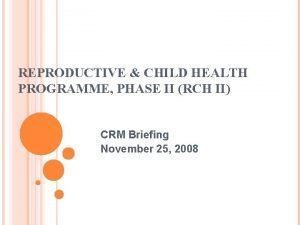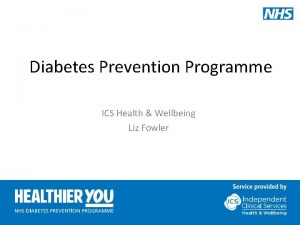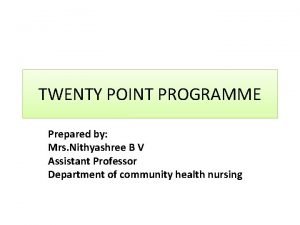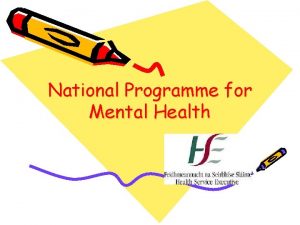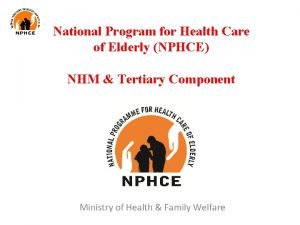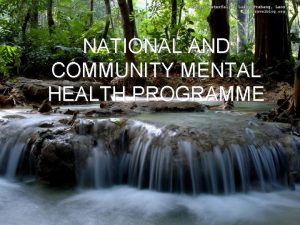School Health Service and Programme INTRODUCTION School health














- Slides: 14

• School Health Service and Programme

INTRODUCTION • School health is an important branch of community health. according to modern concept, school health service. . • The beginning of school health service 1909, • In 1961 the five year plan, many state provided for school health and school feeding program.

Health problem of the school child • • • Malnutrition Infectious diseases Intestinal parasites Disease of skin, eye and ear Dental caries

AIM & OBJECTIVES Comprehensive Care’ for the Health & Well being of all children. 1. Promotion of Positive Health 2. Prevention of Diseases 3. Early Diagnosis, Treatment & Follow up of defects. 4. Awakening Health consciousness in children. 5. Provision of Healthful environment.

School Health Programme Services provided: • Health check up • Prevention of communicable disease • Sport treatment • Referral services • treatment for Heart , Kidney and Cancer disease including renal transplant • Nutritional services

What is school health education? .

Why should care about health education? Health education Skills, knowledge and positive attitudes Emotional health Social health Physical health Mental health

• WHO: An effective school health programme can be one of the most cost effective investments , improve education and health • WHO promotes school health programmes as a strategic means to prevent important health risks among youth and to engage the education sector in efforts to change the educational, social, economic and political conditions that affect risk.

School health and youth health promotion: facts • all deaths of young people between the ages of 15 and 29 are attributable to alcohol use. • all new HIV infections occur among 15 -24 year olds. • Worm infections are the greatest cause of disease among 5 -14 year old children. • Vitamin A deficiency is the single greatest cause of preventable childhood blindness. • Iodine deficiency is the single most common preventable cause of mental retardation and brain damage in children.

• Injury is the leading cause of death and disability among school-age youth. • One out of two young people who start and continue to smoke will be killed by tobacco -related illness.

School health Focuses • Caring for oneself and others • Making healthy decisions • Building capacities for peace, shelter, education, food, income, , equity, social justice, sustainable development. • Preventing leading causes of death, disease and disability: helminthes, tobacco use, HIV/AIDS/STDs, sedentary lifestyle, drugs and alcohol, violence and injuries, unhealthy nutrition. • Influencing health-related behaviors

LESS DEVELOPED COUNTRIES PRIORITIES • - Malnutrition - Worm infections - Hearing and sight impairments - Timing births and safe motherhood - Breast feeding and child growth - Diarrhoea - Coughs and colds - Home and personal hygiene (include dental) - Malaria - AIDS - Immunisation - Regular and safe water supply

DEVELOPED COUNTRIES PRIORITIES • Personal health care (including personal hygiene and dental care) - Mental and emotional health (including personal and human relationships) - Sex education - Family life education - Nutrition education - Use and abuse of addictive substances (legal and illegal) - Physical activity - The environment - Safety education and accident prevention (including First Aid) -

Thank You
 Aims of school health programme
Aims of school health programme Minus type desk
Minus type desk Objectives of school health programme
Objectives of school health programme Objectives of rch programme
Objectives of rch programme National program related to child health and welfare ppt
National program related to child health and welfare ppt Role of nurse in rch phase 2
Role of nurse in rch phase 2 Ics health and wellbeing diabetes prevention programme
Ics health and wellbeing diabetes prevention programme Twenty point programme was launched in the year
Twenty point programme was launched in the year Introduction for cultural programme
Introduction for cultural programme National programme on school standards and evaluation
National programme on school standards and evaluation Mental health programme
Mental health programme National program for the health care of elderly
National program for the health care of elderly National health programme
National health programme National health programme
National health programme Objectives of community mental health
Objectives of community mental health





